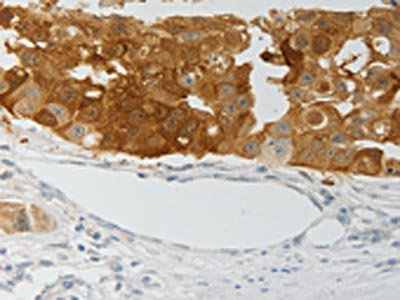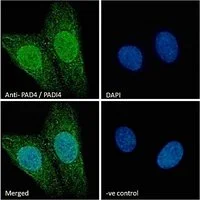PAD4 antibody
GTX113945
ApplicationsWestern Blot, ImmunoHistoChemistry, ImmunoHistoChemistry Frozen, ImmunoHistoChemistry Paraffin
Product group Antibodies
TargetPADI4
Overview
- SupplierGeneTex
- Product NamePAD4 antibody
- Delivery Days Customer9
- Application Supplier NoteWB: 1:500-1:10000. IHC-P: 1:100-1:1000. *Optimal dilutions/concentrations should be determined by the researcher.Not tested in other applications.
- ApplicationsWestern Blot, ImmunoHistoChemistry, ImmunoHistoChemistry Frozen, ImmunoHistoChemistry Paraffin
- CertificationResearch Use Only
- ClonalityPolyclonal
- Concentration2.85 mg/ml
- ConjugateUnconjugated
- Gene ID23569
- Target namePADI4
- Target descriptionpeptidyl arginine deiminase 4
- Target synonymsPAD, PAD4, PADI5, PDI4, PDI5, protein-arginine deiminase type-4, HL-60 PAD, PADI-H protein, peptidyl arginine deiminase, type IV, peptidyl arginine deiminase, type V, protein-arginine deiminase type IV
- HostRabbit
- IsotypeIgG
- Protein IDQ9UM07
- Protein NameProtein-arginine deiminase type-4
- Scientific DescriptionThis gene is a member of a gene family which encodes enzymes responsible for the conversion of arginine residues to citrulline residues. This gene may play a role in granulocyte and macrophage development leading to inflammation and immune response. [provided by RefSeq]
- Storage Instruction-20°C or -80°C,2°C to 8°C
- UNSPSC12352203
References
- Fusobacterium nucleatum-triggered neutrophil extracellular traps facilitate colorectal carcinoma progression.Read more
- An African-Specific Variant of TP53 Reveals PADI4 as a Regulator of p53-Mediated Tumor Suppression.Read more
- NETosis in the pathogenesis of acute lung injury following cutaneous chemical burns. Surolia R et al., 2021 May 24, JCI InsightRead more
- Surgical site peptidylarginine deaminase 4 (PAD4), a biomarker of NETosis, correlates with insulin resistance in total joint arthroplasty patients: A preliminary report. Martins VF et al., 2021, PLoS OneRead more
- Extracellular DNA Correlates with Intestinal Inflammation in Chemically Induced Colitis in Mice. Maronek M et al., 2021 Jan 6, CellsRead more
- The Role of NETosis in Systemic Lupus Erythematosus. Salemme R et al., 2019, J Cell ImmunolRead more





